Many people like to go off-roading on the beach. Some like to try and drive their car as far as they can, while others might be reading a book or watching the sunset. This is where you would need to know if an AWD vehicle can drive down a dune on a beach. The question arises: Can you drive an AWD on the beach?
The AWD Vehicles can be capable of driving on the beach for a short amount of time. If the seawater continues to get into the engine, it could cause a lack of power or even an anti-lock braking system failure. The AWD can get stuck on the beaches if there is not a lot of traction under the vehicle.
Can You Drive an AWD on The Beach?
The main thing that makes AWD vehicles drive on the beach is their traction control system. If there is any sand or mud on the AWD vehicle, it will use this to grip onto to help the car crawl up the dune. However, At some point, the vehicle’s wheels will stop spinning on the beach, and it won’t have the power or traction that it needs to continue moving to get through deep sand.
The AWD vehicles are designed for off-roading on the sand, but it doesn’t mean that you can’t get stuck. If the vehicle does get stuck in the sand, it is important not to rev the engine too high because it could cause damage to the transmission and other parts.
You may also try using sand ladders or sand plates to drive your AWD on a beach.
We have created the infographic below that covers the reasons whether you can drive an AWD on the beach. (You are welcome to use and share but please credit us if you do so.)
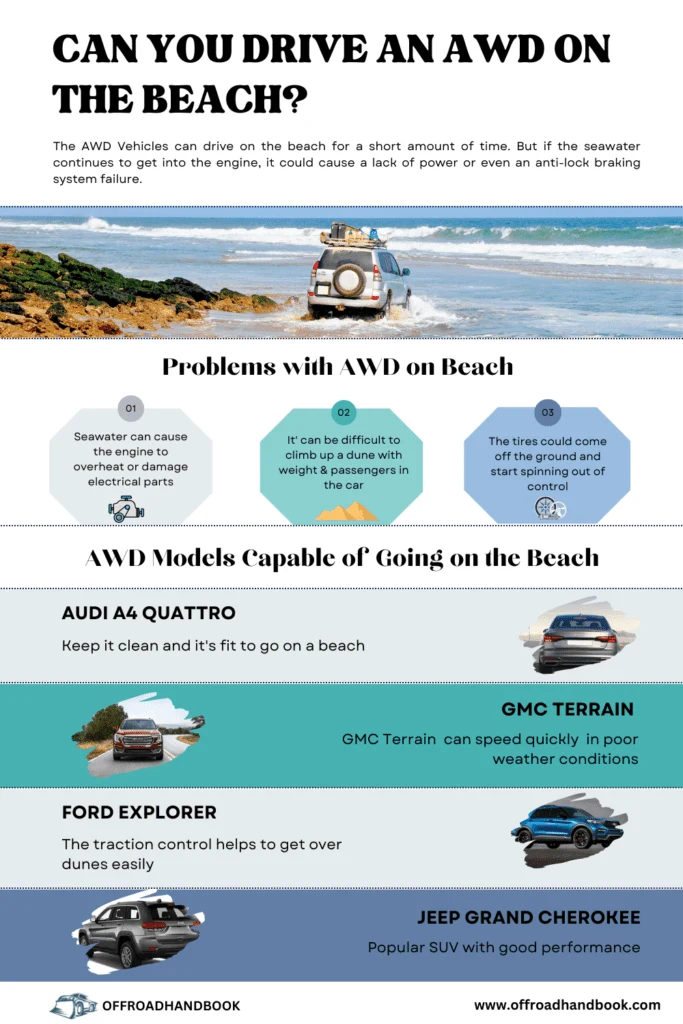
What is a Good Beach Vehicle?
The best vehicle for driving on the beach is a truck or SUV with rear-wheel drive (RWD) because this has more power than front-wheel drive (FWD). This makes it easier to climb over dunes without getting stuck, but you could try both RWD and FWD vehicles to see which ones are most capable of getting over dunes.
Finally, you should look for a vehicle capable of going into the water and climbing up dunes because this is what makes a 4WD car good for driving on the beach. Or you can always ride a horse if you want to experience the beach in a more relaxing environment.
Is AWD Good for the Beach?
Some people think that an FWD or RWD car would be better for the beach. This is because AWD vehicles tend to slip and slide on the sand, which will make it more dangerous when climbing up dunes.
The only time that an AWD might be better than the other types of cars is when you get stuck. The traction control system may help get you out of a tough situation if the sand isn't too bad.
However, I would recommend that you use an FWD or RWD vehicle for the beach. This is because these vehicles will be able to drive up a dune with little trouble and handle it more safely than an AWD vehicle.
Is AWD Safe on Sand?
The AWD vehicles are not the best option for driving on sand. When the traction control is engaged, it will make it easier to climb up a dune, but you are more likely to flip over when trying to drive down one.
Therefore AWD vehicles are better used in ice or snow because they can get better traction on slippery surfaces. But even if you have the traction control system on when driving on sand, it can still cause problems because the sand will get inside the engine and create more bad effects when driving off-road.
What Kind of Problems Might You Encounter with AWD on Beach or Sand?
- As well as getting stuck in sand or mud, an AWD vehicle is more likely to have engine problems. The seawater may cause the engine to overheat, or it could even damage electrical parts, such as your steering wheel or airbags.
- Another problem with an AWD vehicle is that when you climb up a dune with weight in the car, it can cause problems, especially if you have extra passengers or luggage. Even if it doesn’t cause problems, the extra weight can make it more difficult to drive up a dune.
- There is also a chance that when you go down a dune on an AWD vehicle, the tires could come off the ground and start spinning out of control because of all the sand underneath them. This is another reason AWD is not the best option for driving on sand.
Most cars are better off without getting stuck in the sand, especially if they don’t have enough water to cool down their engine. Because of this, I would recommend using an FWD or RWD over an AWD vehicle when going off-roading on the beach.
AWD Models Capable of Going on the Beach:
The below AWD models are somewhat capable of going on the beach:
1. Audi A4 Quattro:
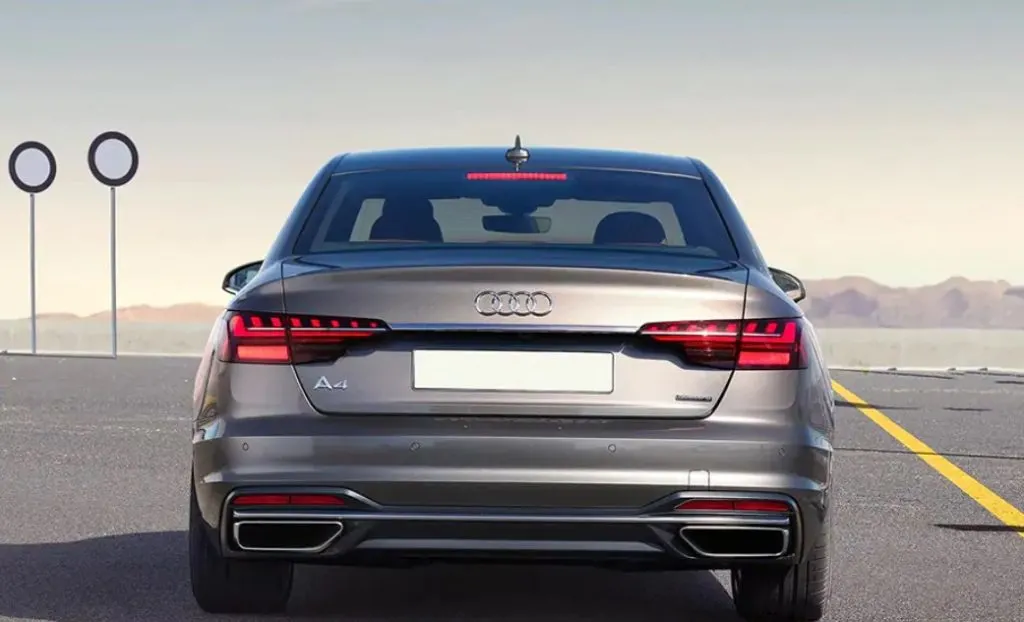
Audi A4 Quattro can go on the beach for some time, but it needs to be kept clean because seawater can get into the engine and ultimately ruin it.
The Audi A4 Quattro can go on the beach due to its traction control system and all-wheel drive (AWD). Some people say that an FWD or RWD vehicle would be a better option, but the Audi A4 Quattro can get up to speed quickly with AWD.
2. GMC Terrain SLT:
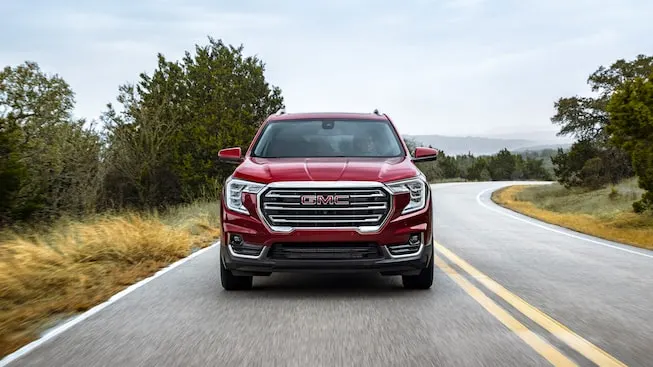
The GMC Terrain can go on the beach because it has all-wheel drive (AWD). This can help to get up to speed quickly in poor weather conditions and helps you climb up dunes easier than an FWD or RWD vehicle.
3. Ford Explorer:
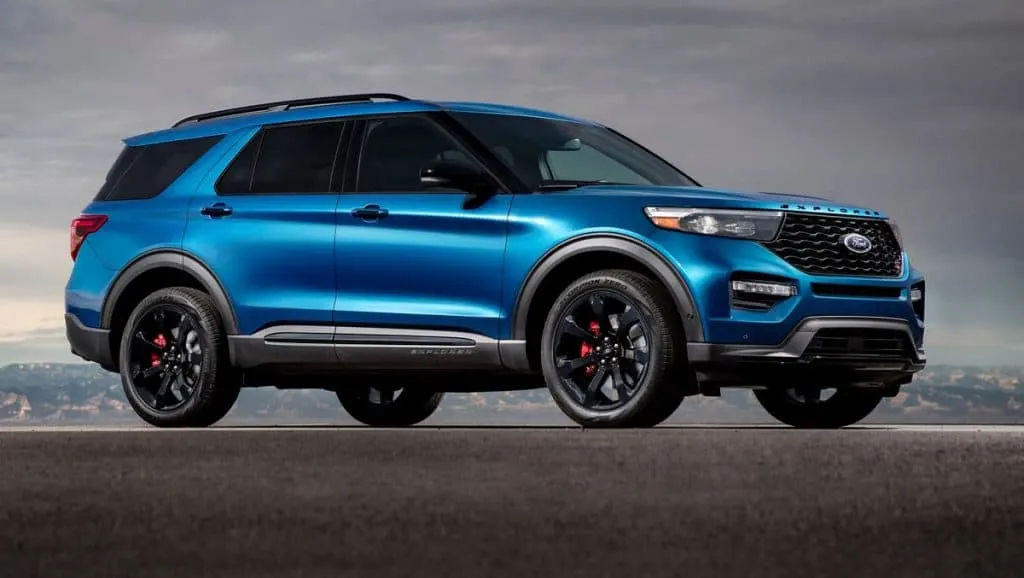
The Ford Explorer is one of the most popular SUVs because it has a lot of power, and it can go on the beach with its all-wheel drive (AWD) system. The traction control also helps to get over dunes easily, but this could be dangerous if you have heavy loads in the car.
4. Jeep Grand Cherokee:

The Jeep Grand Cherokee is another popular SUV because it has good performance, and it can go on the beach with its all-wheel drive (AWD) system.
Which AWD to Avoid while Going on the Beach:
The below AWD models are not capable of going into the beach:
1. Subaru Legacy:
The Subaru Legacy comes with an all-wheel drive (AWD) that allows it to go into the snow, but it isn’t designed to go on sand or water. This is another reason you should not take a Subaru Legacy onto the beach because even though the vehicle could get over dunes, it would be very dangerous while doing so.
2. GMC Acadia:
The GMC Acadia comes with an all-wheel-drive (AWD) feature that can help it go into the snow, but this system is not supposed to be used on the sand. You should only use your GMC Acadia on the beach if you’re lost and need to find shelter.
Points to Remember while Taking AWD to Beach:
- If you’re driving on the beach with a car that has all-wheel drive (AWD), then make sure you have extra water and fuel available in case your engine overheats while climbing dunes.
- Always keep the wheel rims clean because if they get covered in wet sand, it can clog up your brakes, and you could be stranded in a dangerous situation.
- Always check the engine oil because if it gets full of sand, then there’s a good chance your engine will stop working quickly.
- You should also make sure to carry a towrope with you because this can save your life if you get stuck in the sand or need to pull another vehicle.
- Finally, always be careful when driving on the beach because you could get stuck if it’s too soft and has your car damaged by a passing 4X4 that doesn’t see you there.
AWD Vs. 4WD- Which is Better Performer on the Beach?
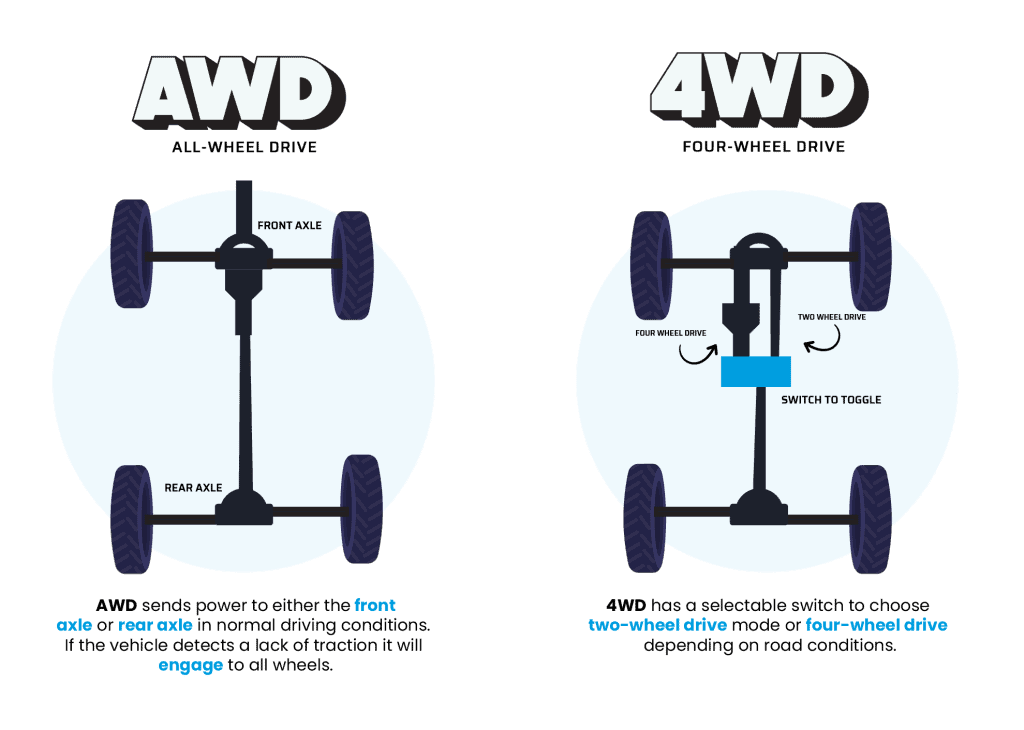
The answer is 4WD. 4WD has an additional axle that sends power to all four wheels, so if one wheel loses its grip, it can still have the power of two or more wheels helping it. This is why more people should use 4WD on sand because it can help you climb up dunes easier than an AWD system.
On the other hand, you may not want take a 4WD vehicle onto the beach unless you know how to drive it correctly because if you go into deep water or soft sand, this could potentially damage your car.
If you do decide to drive a 4WD vehicle on the beach because you know how to handle it, then make sure that your tires are at their best and you have low-range gearing as well as a heavy-duty winch.
This will allow you to get over dunes quickly and help if your car gets stuck in mud or deep water.
What is a Good Beach Vehicle?
The best vehicle for driving on the beach is a truck or SUV with rear-wheel drive (RWD) because this has more power than front-wheel drive (FWD). This makes it easier to climb over dunes without getting stuck, but you could try both RWD and FWD vehicles to see which ones are most capable of getting over dunes.
Finally, you should look for a vehicle capable of going into the water and climbing up dunes because this is what makes a 4WD car good for driving on the beach.
Things to Carry While Driving on the Beach:
Make sure you carry the below equipment with you while driving on the beach:
- Towrope
- Shovel
- Extra water and fuel
- Awnings or sun canopies
- Food and drinks
- First-aid kit
Is Driving AWD on the Beach Legal?
It depends on where you are. If you’re driving on the beach in North America, it’s probably legal because this is part of public land and can’t be owned by anyone.
However, if you’re driving on the beach somewhere like Italy or France, then it’s illegal to do so. You should always check your local laws before driving on the beach because if it’s illegal, then you could get fined or arrested.
In Australia, you will need to get your permit for a few beaches and national parks to drive your AWD on the beach.
Final Thought:
You should only take your AWD vehicle onto the beach if you know how to handle it and have experience off-roading. This is because an AWD system will not prevent you from getting stuck in the sand, so be responsible when driving on the beach.
Also Read:
Is Manual Better for Off-Roading? 4×4 Transmission
Frequently Asked Questions (FAQs):
How to drive AWD in the sand?
To drive AWD in the sand, you should try to mimic how a 4WD or off-roading vehicle behaves and goes slow while climbing dunes. This is because AWD has no low-range gearing and doesn’t have the necessary tires to climb up dunes.
AWD, 4WD, FWD- Who is the winner while driving on the beach?
The winner is 4WD because this has additional power to the wheels and can help get over dunes. It would be between AWD and FWD if there were a tie because both systems have the same potential when you’re on a flat beach.
What is the best-suited vehicle for driving on the beach?
The best vehicle to drive on the beach would be a truck or SUV with RWD because it has more power than FWD.

This is Surya. I am an experienced off-roader. I have been off-roading for many years across several terrains. I am passionate about 4×4 driving and want to share my knowledge and experience with others.
My goal is to provide you with the most comprehensive and unbiased information about off-roading.
I curated this article through my personal experience and expertise, and I hope it helps you with what you are looking for.

 (+91)9123743026
(+91)9123743026
 24/1 Nibedita Sarani. M.B. Road, Kolkata- 700051, India
24/1 Nibedita Sarani. M.B. Road, Kolkata- 700051, India